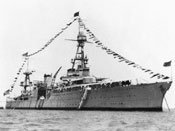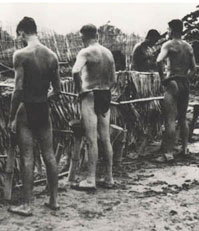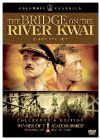 |
North
High School Wall of Honor
Robert Earl Ketman, Jr.
Class of August, 1940
Died: September 5, 1943 |
 |
 |
|
Research done by Rick Nehrling, class of 1963. |
| Robert
Earl Ketman, Jr. |
Robert
is shown in the June, 1940 North High yearbook as being a proposed
August, 1940 graduate. However, official military records indicate
Robert enlisted in the US Navy on June 4, 1940 in Des Moines,
Iowa. His service number is 3218742. Another US Roster shows service
number as 3214287. At the time of his enlistment, attendance at
North High, and military service, his next of kin was listed as
Mr. and Mrs. Robert Earl Ketman, Sr., 1145 19th Street, Des Moines,
Iowa.
He was sent to the Great Lakes Naval Training Station, Illinois,
for training. After training, he was assigned to the USS Houston,
(CA-30), a heavy cruiser, on September 21, 1940. The Houston was
commanded by Captain Albert H. Rooks. |
On December
7, 1941, the Japanese attacked the US Fleet at Pearl Harbor, Hawaii.
Shortly after the attack at Pearl Harbor, the USS Houston was
ordered to join the ABDA (American-British-Dutch-Australian) naval
forces at Darwin, Australia under the command of Admiral Karel
Doorman of the Royal Dutch Navy.
On February 27, 1942, as Japanese amphibious forces were gathering
to invade the island of Java, the ABDA force comprised of the
USS Houston, along with four other cruisers and nine destroyers,
attacked the Japanese invasion forces in the Java Sea. The attack
was repulsed by superior Japanese firepower.
On February 28, 1942, the USS Houston and the HMS Perth, an Australian
destroyer, were at Tanjung Priok, Java, which is the main port
of Batavia (later called Jakarta). They were ordered to sail through
the Sunda Strait, which separates Sumatra from Java, to Tjilatjap,
on the south coast of Java. The USS Houston, was commanded by
Captain Albert H. Rooks, and HMAS Perth, was commanded by Captain
H.M.L. Waller, Royal Australian Navy, both of whom were survivors
of the Battle of Java Sea. Both ships left early in the evening
on February 28th for the Sunda Strait. The only ships they expected
to encounter were Australian corvettes on patrol in and around
the strait.
 |
 |
Feb. 28, 1942:
Battle of Sunda Strait: As the two ships were proceeding
towards the Sunda Strait they encountered a Japanese landing
in progress at Banten Bay. A ferocious night battle took
place during which three Japanese transports were destroyed
- two by friendly fire - and three other Japanese transports
were damaged before the Japanese covering force of three
cruisers and nine destroyers under Read Adm. Takeo Kurita
sank the USS Houston and HMAS Perth.
|
| USS
Houston |
Out of the 1064 men onboard the USS Houston, only
368 survived. On the Perth, out of the 677 men onboard, 307 survived.
The commander of the Houston, Captain Rooks, went down with the
ship. Robert Ketman survived the ship's sinking.
The fate of the Houston was not known for almost nine months,
and the full story of her fight was not fully told until after
the war was over and her survivors were liberated from prison
camps. Captain Rooks posthumously received the Medal of Honor
for his extraordinary heroism.
It has been reported by Houston survivors that the actual sinking
was slow enough to permit many unwounded men to get into the water
and clear the ship. The survivors also stated that many of the
life rafts were placed in the water before the ship sank, and
the crew was equipped with life jackets.
The Japanese did not start to pick up any survivors until dawn.
By that time, the majority of the survivors had reached the shores
of Java and were scattered over a distance of about twenty miles.
It was reported that survivors spent anywhere from 8-12 hours
in the water before they reached land or were picked out of the
water. All Houston survivors were captured and turned over to
the Japanese Army. (Robert Ketman made it to shore and was captured
by the Japanese Army. He was officially reported by the Japanese
as a POW in February, 1943, which was almost one year after the
Houston had been sunk and Robert had been captured by the Japanese
Army).
The survivors, now POWs, were held in the town of Serang, Java
in the local jail and theater for the next six weeks. Conditions
were atrocious with overcrowding, very little food, and limited
sanitary facilities. During the six-week stay in Serang, dysentery
became prevalent, and everyone suffered from malnutrition.
In mid-April, 1942, the surviving POWs from Serang (Robert Ketman
survived Serang) were moved to Bicycle Camp, Batavia. Already
in this camp were a large number of Australian and Dutch prisoners.
All of the POWs remained at Bicycle Camp until October 1, 1942.
On October 1, 488 Americans, 385 Australians, and 159 Dutch prisoners
were transported from the Bicycle Camp to Singapore where they
remained until January 7, 1943. (Robert Ketman was in this group
of Americans.)
On January 7, the prisoners were transported by train from Singapore
to Penang, British Malaysia. Here they boarded a Japanese "hellship",
the Moji Maru. They set sail with another "hellship", the Nichimei
Maru which was loaded with over 900 Dutch prisoners and Japanese
troops. The two ships were to convoy together enroute to Moulmein
(later called Mawlamyine), Burma. On January 15, 1943, the two
transport ships were bombed by two US B-24s and two PBYs. The
plane bombing runs sank the Nichimei Maru, killing most of the
Japanese troops and approximately 50 Dutch POWs. The survivors
were loaded onto the Moji Maru and continued on to Moulmein. (Robert
Ketman survived this attack).
The Moji Maru arrived at Moulmein on January 16, 1943. The POWs
were kept in the district jail until January 27, 1943, when they
were moved by rail to Thanbyuzyat, Burma about 40 kilometers southeast
of Moulmein. They were then loaded onto trucks and driven to Hlepauk
camp which was 18 kilometers from Thanbyuzyat. This was the beginning
of their work in constructing the Burma-Thailand Railway linking
Rangoon, Burma (now called Yangon, Myanmar) to Bangkok, Thailand.
Once the railroad was completed, the Japanese could move men and
supplies quickly between Thailand and Burma. |
| The railroad was
to become 421 kilometers (approximately 250 miles) long
with a height difference of 300 meters and had numerous
crossovers and bridges. The majority of the railroad construction
was through the jungles and mountains of Thailand and Burma.
The railroad construction was made famous in the 1957 Academy
Award-winning motion picture, "The Bridge Over the River
Kwai." |
 |
 |
 |
 |
| Audio;
"Bridge
Over River Kwai" |
American POWs
during building of railway, bridge |
Bridge, Book |
|
When the
Americans arrived at the first railroad work site in late January,
1943, they were in good physical condition. However, life as a
captive forced laborer on this railroad construction was extremely
hard and difficult. Survival was almost impossible. The men were
on death row, and they knew it. During the railroad construction,
many thousands died from undernourishment, hard labor, torture,
tropical disease, and neglect.
The Japanese were merciless task masters and bludgeoned men into
long hours of spirit-destroying work. The job was ardous in the
extreme, particularly for the many men who had to work barefoot.
The long working hours, the intense harassment on the job, the
lack of footwear, and the starvation diet affected men's health
to a point where they became very vulnerable to all the tropical
diseases that were indigenous to the area. Men worked while they
lasted, and as men died, the Japanese would get more POWs or native
labor to work in order to meet the railway construction target,
which was 2 kilometers a day.
Malaria and dysentery were the POWs' constant companions. There
was little quinine available to control malaria and nothing with
which to treat amoebic dysentery. A lack of vitamins in the diet
soon brought on all sorts of other complaints ranging from beri-beri
to red raw mouths, tongues, and throats. Cuts and wounds on the
legs and feet generally became infexted due to the absence of
antiseptics, disinfectants, and bandages. Many lesions soon turned
to tropical ulcers which often became gangrenous requiring the
infected limb to be amputated.
The Houston survivors were placed in a group known as Group 5
and assigned to a work camp where they lived and worked. Once
the work near that camp was completed, the men were moved to another
camp and lived and worked from that camp. The camp names were
based on the distance (kilometers) from the Base Thanbyuzayat
and the name of the nearest village. Consequently, all camps had
the village name and kilometer distance from Thanbyuzayat.
The first camp that Group 5 and Robert Ketman were assigned to
was Hlepauk or 18 Kilo Camp in January, 1943. In early March,
the Group was moved to Apalaine Camp or 80 Kilo Camp. In late
March, the Group was moved again, this time to Lawa Camp or 85
Kilo Camp. In early May, the Group was moved to Regue Camp or
100 Kilo Camp. By late May, which was when the rainy season started,
the first American from Group 5 died.
Robert Ketman survived the first three work camps, but on September
5, 1943, he died from the complications of amoebic dysentery and
tropical ulcers at the Regue Camp or 100 Kilo Camp. He was buried
at the 100 Kilo Camp's cemetery in grave number 120.
Another record of his burial: He died at the 100 Kilo Camp and
was buried in that Campís cemetery. That is according to the official
records. A couple of references were found that stated that he
was removed from that Campís cemetery and that he was reburied
in the Barrackpore Cemetery in India along with 1500 other POWs.
When that cemetery was closed in 1948, he was reburied in Hawaii
in the Punchbowl Cemetery. Unfortunately, we were never able to
find him on the official records at either site.
It is estimated that 61,000 POWs and 250,000 natives (residents
of the countries) were forced to work on the Burma-Thailand Railway
in some of the most severe and atrocious conditions. The railway,
which was 421 kilometers long of single track and 1 meter gauge,
was constructed in a little over 12 months. Over this period,
approximately 13,000 POWs and 100,000 natives died. |
|
| References |
The
above information was obtained from the following:
(1) The State Summary of War Casualties from World War II for
Navy, Marine Corps, and Coast Guard Personnel was compiled in
April, 1946, by the Casualty Section, Office of Public Information,
Navy Department. It is considered to be the official list of the
World War II dead for the Navy, Marine Corps, and Coast Guard.
These records can be found online at http://www.archives.gov/.
All of the names and information in this document are arranged
by State. Within this document, the Navy states the following:
"Inclusions of names in this State group have been determined
solely by the residence of next of kin at the time of notification
of the last wartime casualty status. This listing does not necessarily
represent state of birth, legal residence, or official state credit
according to service enlistment."
The casualties listed in the document represent only those personnel
on "active duty in the Navy, Marine Corps, and Coast Guard,
resulting directly from enemy action or from operational activities
against the enemy in war zones from December 7, 1941 to the end
of the war." Any casualties in the United States area (training,
other assignment to a permanent duty station in the US, etc.)
or as a result of disease, homicide, or suicide, in any location,
are not included. This document only contains the names of those
individuals who died in the line of duty status. Those individuals
who were not in the line of duty at the time of their death are
not listed in this document.
(2) A USS Houston website that contains detailed information about
the ship and its crew can be found online at http://www.usshouston.net.
This site indicates that Robert Ketman's date of death is Septemer
5, 1943, and that he is buried at Barrakpore Cemetery, Calcutta,
India. Another source stated that this cemetery was closed and
the remains of the POWs were reburied at the Punchbowl Cemetery
in Hawaii.
(3) A site regarding Prisoners
of War of the Japanese can be found online at http://www.pows-of-japan.net.
(4) Information regarding USS Houston
crewmen who died while prisoners of war can be found online at
http://www.texasmilitaryforcesmuseum.org/.
(5)
Information regarding allied POWs in World War II can be found
online at http://www.mansell.com.
(6) The comprehensive list of names from North
High's 1893-2018 graduation classes are from Claradell Shedd's
North Des Moines High School website. The names of all North High
School graduates can be found online at http://www.ndmhs.com/.
Robert Earl Ketman, Jr.'s 1940 class page can be viewed at
http://www.ndmhs.com/pages/yearclass1940(1990.50).html.
|
|
| Deceased:
He died on September 5, 1943 at Regue Camp or 100 Kilo Camp. He is buried
in the cemetery there in Grave #120. His rank was Seaman 1st Class.
|
| Music:
"Bridge Over the River Kwai" |
Home
|
Back/allyears |
WWI |
WWII |
Korea |
Vietnam |
Afghanistan/Iraq |
Lyrics
|
Refs/Awards |
Contact
©2025-csheddgraphics All rights reserved.
All images and content are © copyright of their respective copyright
owners. |
|




